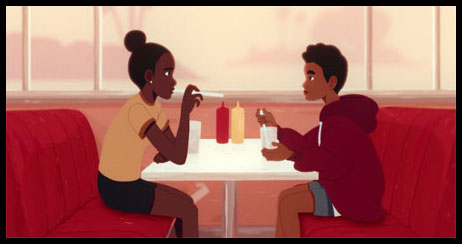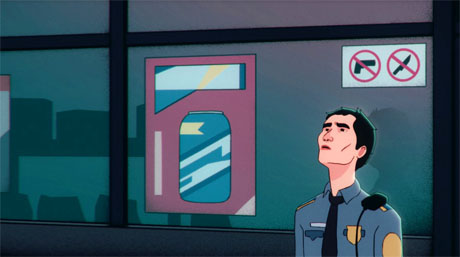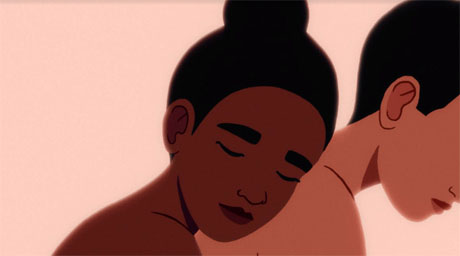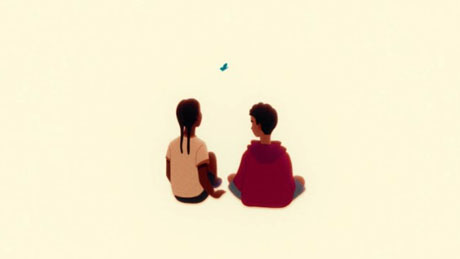
It’s Nice in Here is one of the 15 finalists for the 2023 Best Animated Short Film Oscar. This has been a passion project for director Robert-Jonathan Koeyers, who joins me for this Animation Scoop Q&A to discuss the powerful, thorough short that presents multiple sides to a complicated, heartbreaking story of two best friends and a police officer. (This interview was edited for length and clarity.)
Robert-Jonathan Koeyers: It’s absolutely surreal. We have such a tiny movie, and the entire year… has been so surreal. World Premiere at Cannes and now making it onto the shortlist for the Oscars. It’s like a childhood dream and it’s surreal to believe.
Jackson Murphy: How was that experience at Cannes?
RJK: Equally surreal. (laughs) You’re working for such a long time on a film in your little attic by yourself… well, with a team who’s working remotely… and then suddenly for the film to be out there and for people to engage with it in Cannes was… indescribable.

JM: This story is commentary, and an example, of one of the most talked-about topics of the last couple of years: police interactions with young people, especially African Americans. There are a lot of aspects of this I found powerful. First, what kind of angle and perspective did you really want to take and approach with this topic?
RJK: I’ve been looking around at news stories, and I’ve been seeing these stories unfold of unarmed black people getting shot by police officers, which is a horrific thing. But what I was also interested in exploring and seeing was how these stories were then told — and how narratives were twisted and turned. That’s something I wanted to dive deeper into. How do we remember these events? How do we talk about the people who are no longer there to tell their own story? That was the catalyst with this project: starting off with this idea of, “How do you show one instance but show it through two different lenses?” And how can we talk about truth and memory?

Robert Jonathan Koeyers
RJK: When we hear both of the characters, we wanted it to feel like they are talking to us. So we, as viewers, become almost like the jury members. These two characters, Imani and [David] a police officer, are telling their side of their story, or their testimony, basically. Hearing these two witness statements and drawing our own conclusions from it is what we wanted to start off with. But we also wanted to add a poetic quality to it. When Imani is talking about the world she lives in, we also wanted to show the beauty there. When the police officer is talking about his perspective, we wanted to show the gritty, dark side of the police officer.
JM: And then you do it visually. There’s a sequence towards the end… where you take this ‘two sides’ approach up a notch visually. What went into the process of doing this and the editing? It’s really well done.
RJK: Thank you. We started off with Imani’s perspective and wanting to create a very warm, almost nostalgic feel. I have a live-action background. I feel like that’s also how we basically approached this film. Whenever we see her perspective, the camera’s always moving, almost like a documentary team is following her small, intimate steps. Whereas the police officer’s perspective feels a lot more neo noir and more cinematic, in a sense. And these two perspectives eventually clash-up against each other. Through editing, we wanted to really highlight that. What does it feel like when two perspectives, or two flavors, or two sides of the story clash into each other and get twisted up?

JM: What made animation right for this story and project?
RJK: The film is very much about memories, and how we remember or misremember things. Animation allowed us to work with two different visual styles for each of the perspectives, which is something we couldn’t do with live-action. We could also sometimes have small elements in the background — flicker away or change colors — to mimic this fallibility of our memories. Things are not always as certain or as steady, but things are ephemeral, in a sense. That’s something we could do with animation, and that’s what I love about animation. We can literally construct and tell anything we want to.
JM: Absolutely. I was going to mention the backgrounds because you take kind of a minimalist approach with them, but there are key things you do with them. And the fact that it’s about our memories… maybe we don’t remember exactly everything that’s in the background. It’s a color. It’s a mood. It’s a feeling. That really works.
RJK: Exactly. Thank you. That’s exactly what we went for. If I think of my favorite memories, I think of an object in a corner, or a color, or a feel, but I don’t remember the exact… every single detail in that space. That’s what we wanted to also mimic in the film.

JM: Imani and Crimson are so young. And the way you build that relationship early on through how she tells the story, and we see them in the bathtub and different places, adds to the emotion you have for them. It adds to the entire situation. How did you want to build that relationship and have us experience that, especially early on?
RJK: I wanted to make this perspective full of love — for each other. These two best friends that mean something for each other. But also to make this loss at the end of the film feel that much more painful. The entire film is about a contrast of these two perspectives, but it’s also about how warm the film opens and how beautiful and poetic and warm it feels. To contrast that with brutal [events] at the ending… I wanted to very much show blackness from a softer perspective and show a quiet, black, young boy, live his life. And we could only do that through Imani’s perspective and see him in the way that only she could.
JM: There is a line that David, the police officer, says at one point, “It was a forever kind of day.” I think all of us, in some way, can relate to that. We’ve had long and tough days. But especially for police officers, feeling that way. What kind of research of the lives of police officers did you do? We see his family life a little bit, and I thought the rotating partners [sequence] was a unique angle.
RJK: In 2017, I did a lot of research for the film. My dad used to be a police officer back in Aruba. So that helped a lot, with asking questions: “What was it like? How did you deal with very tense situations?” But he also introduced me to a lot of his older colleagues that he used to work with. I also got to interview them and have conversations with them about their experiences. With that, I tried to see it from a perspective that I wasn’t necessarily used to embodying.

JM: There’s a lot of depth that you bring, and I have to imagine there were parts of it that you wanted to make sure you HAD to get right. You have to FEEL like it’s 100% of what you want it to be. What was the aspect you needed to make sure was as good as it could possibly be?
RJK: That’s a really good question. I think a level of authenticity was really important. I wanted the characters to feel real. I didn’t want to seep into stereotypes. One of the rules we had from very early on was that the police officers cannot eat doughnuts. It would become a very stereotypical way of showing police officers that we’ve seen so many times. I didn’t want to necessarily vilify either side or sketch a very evil, cartoony villain. We’ve seen that film before and we wanted to explore these characters — who they really are, beyond their uniform and facades. Who are these characters? What do they mean to each other? Make them feel as real as possible, even though we’re using animation.
JM: Yes. That authenticity is absolutely there. I’m glad you avoided stereotypes because you don’t take the easy way out when it comes to dealing with this topic. You take a realistic approach, and it really shows. You are 30 years old, which is amazing. You are one of the youngest people I think I’ve ever [interviewed] about animation. What would you say to young people who want to get into animation and can achieve this major, major goal at 30?
RJK: Look at yourself and the story you have to tell. I feel like everyone has a story to tell. Try to see what you want to explore. What do you want to have people engage with? And surround yourself with people that can help you with that. I didn’t do this film by myself. I had such a big team of people who were better at certain things than I was, and that helped me a lot. With animation, you can go as far as you possibly can. If you find the right people to help you get to that point, it will feel all the more rewarding.
JM: That is so true. You are going to inspire a lot of people, especially young people, through this.
RJK: Thank you. Wow.
JM: This is an important film. What would it mean to you to officially be nominated for an Academy Award — to get to go to the show and maybe be up on stage… and to have this film be a representation of the past year in animated shorts?
RJK: It would mean the world to me. It would really be life-changing, I think. Not only for this film to also get more attention and for more people to be able to see it, which is our ultimate goal, of course, but also just to get the recognition for stories like these to be told. And hopefully, like you said, we’ll inspire more people to also tell authentic stories about their life experiences.
- INTERVIEW: “Inside Out 2” Director And Producer On Pixar Sequel - April 16, 2024
- INTERVIEW: “Puffin Rock And The New Friends” And 25 Years Of Cartoon Saloon - April 10, 2024
- INTERVIEW: “Chicken For Linda!” Directors On Annecy Winning Feature - April 9, 2024


 January 7th, 2023
January 7th, 2023  Jackson Murphy
Jackson Murphy  Posted in
Posted in  Tags:
Tags: 






